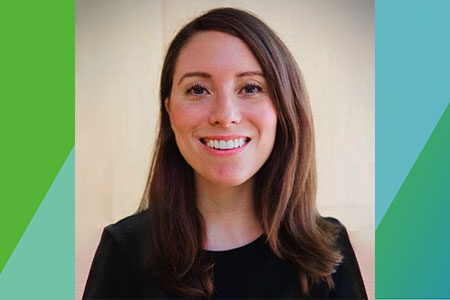OICR recently welcomed Dr. Grace Egan to the OICR community as the recipient of an Early-Career Investigator Award.
As a staff physician at the Hospital for Sick Children, Dr. Grace Egan sees firsthand the need for better, more-targeted treatments for children, adolescents and young adults with acute myeloid leukemia (AML). This is what compelled her to explore the underlying biology of different subtypes of AML, so that therapies can be tailored to the specifics of each patient’s cancer.
Dr. Egan joined OICR News and explained how she is helping to bring a badly-needed upgrade of AML treatments to her patients and others around the world.
How did you become interested in cancer research and in particular childhood and young adult leukemias?
My work as a pediatric oncologist motivated me to explore and understand the biology of high risk leukemia so that we can develop more effective, targeted therapies for this disease.
Many of the chemotherapies that we use in the clinic target both leukemic and healthy cells, resulting in a lot of side effects for patients. In addition, chemotherapy regimens and hematopoietic stem cell transplants for high risk patients, have been maximized to the limits of toxicity in AML.
The only way to improve outcomes for children and young adults with AML is to understand the biology of the disease so that we can identify vulnerabilities in leukemia cells that can be selectively targeted, while sparing healthy cells.
Can you tell us about your research and how it will help patients?
The primary goal of my research program is to identify new therapeutic targets for childhood AML. We know that the biology of AML in children and young adults is very different to the biology of AML in older adults. We need to identify targets specifically for this younger population, instead of assuming drugs effective in older adults with AML will be effective in younger patients, as frequently they are not.
Currently, I’m focused on studying importins and exportins, which are the gatekeepers that allow proteins into and out of the nucleus. The nucleus of a cell is where the cell gets the instructions on how to behave, grow and divide. If proteins move into or out of the nucleus at the wrong time, this can give faulty instructions to the cell that can cause cancer to develop. There are a number of different importins and exportins and many of these have not been studied extensively in leukemia.
We have identified that childhood and young adult AML may be uniquely reliant on some of these exportins, and this offers avenues for potential treatment, if specific inhibitors can be developed.
What inspires or drives you to push forward with your research?
Working on the wards and treating children and adolescents with high risk leukemia, is daily inspiration to keep pushing forward tenaciously with my research.
I have witnessed first-hand how cancer research has revolutionized the treatment of childhood acute lymphoblastic leukemia (ALL), where survival outcomes are now higher than 90 per cent. In contrast to ALL, AML remains more difficult to treat at both diagnosis and recurrence, and survival outcomes are very poor in children who relapse.
The only way to improve outcomes for children and AYA with AML is to identify novel, preclinical targets that focus exclusively on biologic vulnerabilities unique to younger AML patients.
How do you think new technologies and other advancements will change clinical trials and treatment for childhood and young adult leukemias?
Technology is already changing how we treat children and young adults on clinical trials.
Next generation sequencing, including the use of RNA sequencing, has enabled us to identify patients whose leukemia cells contain high risk genetic abnormalities – previously these high risk patients would have slipped through the cracks and relapsed. For these high risk patients we can intensify treatment with the use hematopoietic stem cell transplant and more recently, specific targeted agents for some subsets, for example, AML with a mutation in the FLT3-ITD gene.
The challenge now, is that most high risk genetic abnormalities in AML are not directly druggable and their role in downstream biologic processes is still not well understood. The future of AML treatment requires understanding the mechanisms that drive distinct subsets of childhood and young adult AML so that we can tailor treatment to the unique biologic drivers of each patient’s leukemia, thus improving treatment efficacy and reducing off-target side effects. Efforts are underway to make this vision a reality though international collaborative research groups including the Pediatric Acute Leukemia Master Clinical Trial (LLS PedAL).
How will joining OICR as an Early-Career Investigator advance your research?
I’m very grateful to be an Early-Career Investigator with OICR. The support of OICR enables me to accelerate the work I am doing and offers exciting opportunities to advance our discoveries to the next step, through use of the Cancer Therapeutics Innovation Pipeline initiative, for example.
In addition, the ability to work with, and learn from international experts in AML research, including Dr. Aaron Schimmer and Dr. John Dick has been an incredible opportunity for me. I am looking forward to continued collaborations with researchers at OICR, SickKids Research Institute, Princess Margaret Cancer Centre, and across Ontario’s research community.


